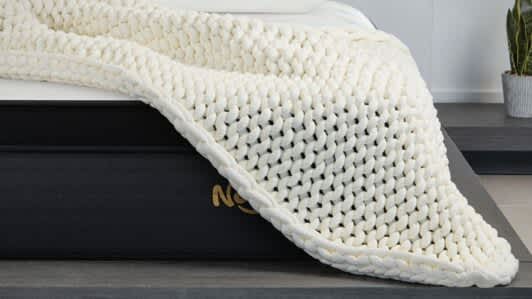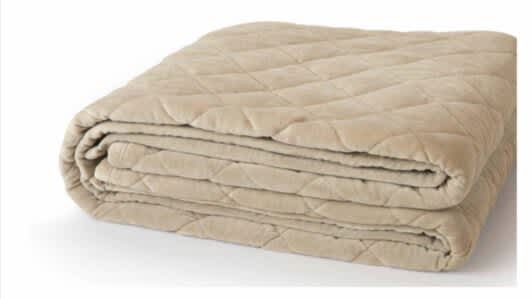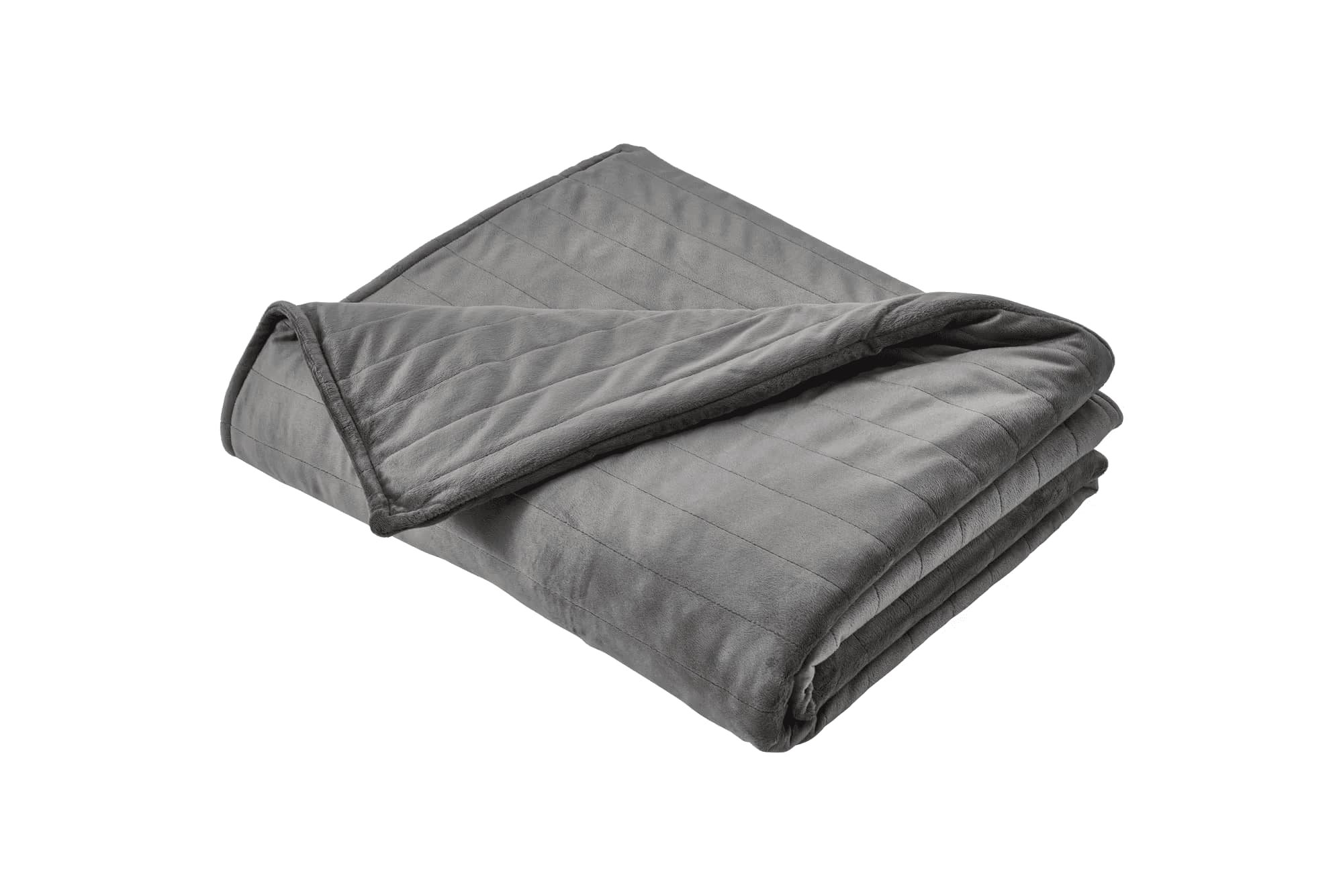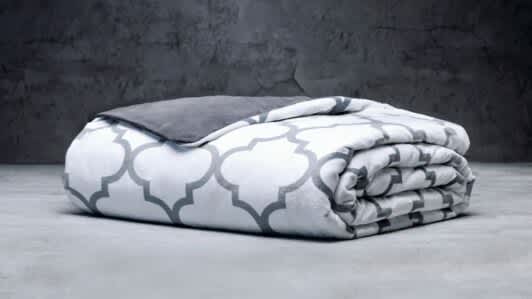On This Page
Best Weighted Blankets: Our Top Picks
Our Top Picks
-
Best Overall Weighted Blanket
Bearaby Velvet Napper -
Best Value Weight Blanket
Nolah Chunky Knit Weighted Blanket -
Best Luxury Weighted Blanket
Saatva Organic Weighted Blanket -
Most Comfortable Weighted Blanket
Tempur-Pedic Weighted Blanket -
Softest Weighted Blanket
Luxome Weighted Blanket -
Best Cooling Weighted Blanket
Brooklyn Bedding Chunky Knit Weighted Blanket -
Weighted Blanket with Best Design
Baloo Weighted Blanket
Best Overall Weighted Blanket

The Bearaby Velvet Napper’s silky-smooth feel and open-knit design set it apart from many competing models sold today. Available in three weights, the blanket caters to a wide swath of body types, and the eco-friendly fabric is a nice touch.
Pros & Cons
Pros
- Plush eco-friendly velvet made from upcycled plastic bottles
- Available in three weights: 15, 20, or 25 pounds
- Six color choices
Cons
- Edges may curl in over time
- Limited weight options for people under 150 pounds
Full Details
Best Value Weight Blanket

Thanks to its open-knit design, the Nolah Chunky Knit Weighted Blanket promotes ample airflow and doesn’t retain much heat. Polyester jersey yarns also ensure a soft feel that’s easy on your skin.
Pros & Cons
Pros
- Open-knit construction delivers steady airflow
- Polyester jersey yarns are soft and smooth
- Two color options
Cons
- Only one weight option
- Blanket is not machine-washable
Full Details
Best Luxury Weighted Blanket

Saatva’s Organic Weighted Blanket delivers a luxuriously soft hand-feel thanks to its quilted velvet cover. With weight options of 12 and 20 pounds, most of our testers found a design that provided sufficient compression.
Pros & Cons
Pros
- Plush velvet cover made from organic cotton
- Natural glass beads for consistent pressure
- Available in two sizes and two colors
Cons
- More expensive than average
- No options for twin or twin XL mattresses
Full Details
Most Comfortable Weighted Blanket

The Tempur-Pedic Weighted Blanket provides some of the best weight distribution we’ve seen firsthand in our testing lab. Vertical quilting keeps the fill isolated, so you should never have to deal with the clumping or shifting people tend to encounter with baffle-box blankets.
Pros & Cons
Pros
- Glass beads are secured in pouches for even pressure
- Machine-washable polyester cover
- Two weight options: 15 or 20 pounds
Cons
- Bothersome heat retention may occur
- Weights limited to two options
Full Details
Softest Weighted Blanket

The Luxome Weighted Blanket is so soft and cozy. I especially enjoyed the dual-sided design with the minky fabric on one side and cooling lyocell on the other. The weight range is also impressive — most people should find a good match with the available options regardless of their body type.
Pros & Cons
Pros
- Wide range of weights to suit different body weights
- Glass beads provide deep compression without trapping too much heat
- Available with an integrated or removable cover
Cons
- Only one size for each weight option
- Heavier blankets may be too bulky for household washing machines
Full Details
Best Cooling Weighted Blanket

The Brooklyn Bedding Chunky Knit Weighted Blanket’s open-knit design made it one of the most breathable weighted blankets we’ve tested, which appealed to our hot sleepers. The given weight range made the blanket most comfortable for our testers between 80 and 180 pounds.
Pros & Cons
Pros
- Open-knit construction encourages airflow
- Two weight and color options
- Jersey-knit yarn feels soft to the touch
Cons
- Only available in two weights
- Difficult to keep clean
Full Details
Weighted Blanket with Best Design

The Baloo Weighted Blanket is soft, smooth, and thin without sacrificing deep compression. Our team’s hot sleepers were particularly impressed with the breathable design, and an extensive weight range means most people can find a comfortable option.
Pros & Cons
Pros
- Four weight options ranging from 12 to 25 lbs.
- Available in four shell colors
- Fully machine-washable for quick and easy care
Cons
- Blanket may trap heat
- Somewhat expensive compared to the competition
Full Details
How We Test
There are a lot of qualities to consider when choosing which weighted blanket to buy. Luckily, our team does all the heavy lifting (pun intended) for you. Our product experts personally try out every weighted blanket that appears on our site, examining them for performance features and quality. We look at how the blankets are constructed, which can indicate how well they’ll hold up and whether the weighted fill will leak or bunch over time.
The fabric quality is also important, so the team examines materials to learn about their weaves, textile source, and the quilting or stitching that keeps the weighted fill in place. We try every blanket ourselves to see how well the weight options work for different body types on our team and we also take notes on how cozy or breathable a model feels. Before making a final recommendation, we consult existing customer reviews to learn what current owners think of their weighted blanket model.
What Is a Weighted Blanket?
A weighted blanket is designed to relax sleepers by applying even pressure on the body. They are much heavier than regular blankets, weighing anywhere from 5 to 30 pounds. The hugging sensation activates deep pressure stimulation, which studies have shown can help reduce anxiety.
Most weighted blankets fall into one of two types: knitted or duvet. Knitted models have a layer-on-layer design made with sturdy yarn. Duvet styles combine a weighted interior with a separate cover. Common types of fill materials include glass, plastic, ceramic, or steel beads.
In general, a weighted blanket should be about 10% of a user’s body weight. This ratio tends to balance comfort and temperature control for most sleepers.
Are Weighted Blankets Safe?
Weighted blankets are generally considered safe as long as users follow recommended weight guidelines. They aren’t suitable for children under age 3 or people with certain health conditions like low blood pressure, diabetes, or sleep apnea.
How Much Do Weighted Blankets Cost?
Shoppers can expect to pay between $100 and $300 for a weighted blanket. Prices vary based on the brand, materials, size, and shipping fees.
Getting a blanket that’s the right ratio for your body weight is important. Generally, the rule of thumb is that you should opt for a blanket that weighs around 10% of your body weight.
What Are the Benefits of a Weighted Blanket?
Weighted blankets are used for a variety of reasons, and not everyone will experience the same benefits. That said, many users report being able to fall asleep quicker and stay asleep longer. Their swaddling sensation is thought to modulate the autonomic nervous system, which may alleviate anxiety for some people.
While more research is needed to thoroughly assess the effectiveness of weighted blankets, trials indicate that they can improve sleep outcomes. In one study, nurses observed that residents at a nursing home fell asleep sooner, had fewer sleep interruptions, slept longer, and had less daytime fatigue when using weighted blankets. The residents were also more eager to go to bed when weighted blankets were introduced.
Another study showed that weighted blankets improved sleep onset, sleep duration, and daytime relaxation in children and adults with attention-deficit/hyperactivity disorder (ADHD) and autism spectrum disorder. Other research suggests that weighted blankets can reduce insomnia symptoms for people with certain psychiatric disorders like major depressive disorder, bipolar disorder, and generalized anxiety disorder.
Weighted blankets activate a user’s touch sensory system in a process known as deep pressure stimulation. By regulating the autonomic nervous system, deep pressure stimulation is thought to reduce anxiety related to excess stress hormones.
The following benefits are associated with deep pressure stimulation:
- Calms the nervous system
- Provides comfort and security
- Eases stress and anxiety
- Improves sleep quality
Who Should Use a Weighted Blanket?
Sleep disorders are associated with a number of physical and psychiatric conditions. Preliminary studies show that weighted blankets can reduce anxiety and insomnia symptoms by balancing the nervous system and reducing stress hormones. The hugging sensation is thought to soothe users by increasing serotonin, a neurotransmitter associated with regulating mood and feelings of happiness and calm.
Research indicates that weighted blankets may also help people with chronic pain. One study found that a 15-pound blanket was especially effective at alleviating chronic pain in very anxious adults.
The therapeutic value of weighted blankets appears promising, but more conclusive research is needed. As such, shoppers should be cautious of any manufacturers making bold health claims.
Who Should Not Use a Weighted Blanket?
When used appropriately, weighted blankets are generally considered safe. However, they aren’t appropriate for young children or those with certain health conditions.
People with circulatory or respiratory conditions like low blood pressure, diabetes, asthma, or sleep apnea should speak to their doctor before using a weighted blanket. The heft of the blanket can potentially obstruct airway passages or restrict circulation.
Some lighter blankets are designed specifically for youth, but children under age 3 or those who weigh less than 50 pounds should not use weighted blankets due to the increased risk of suffocation.
The stitching that holds your weighted blanket together is really important. Low-quality baffles or quilting can mean that you wake up with thousands of tiny beads all over the place.
What Should You Consider When Choosing a Weighted Blanket?
People turn to weighted blankets for different reasons, but every shopper should factor in their weight, health status, and budget when picking a model. Materials, ease of care, and temperature regulation are also important considerations.
Your Budget
Quality weighted blankets typically cost between $100 and $300. Prices vary according to materials, craftsmanship, and size. Heavier and larger blankets tend to cost more than lightweight models. Blankets made with glass and ceramic beads are usually more expensive than those made with plastic pellets. Cover materials also influence pricing.
Be on the lookout for additional costs like shipping fees or customer protection plans. While price is often a reflection of quality, the most expensive design isn’t necessarily the best one for your needs.
Your Weight
A weighted blanket should generally be about 10% of a user’s body weight. For example, someone who weighs 150 pounds would typically want a 15-pound blanket. While not a hard-and-fast rule, the 10% formula works for most people. A blanket that’s too heavy can leave sleepers feeling smothered, while one that is too light might not provide the desired result.
If you’re in between weight options, many manufacturers recommend choosing the heavier of the two. That said, hot sleepers tend to be more comfortable with a lighter model. Kids who are in between sizes should go with the lighter option as a precaution.
Your Health
People with medical conditions like diabetes, low blood pressure, obstructive sleep apnea, or asthma should speak with a medical professional before purchasing a weighted blanket. The heaviness can inhibit breathing and circulation and worsen these conditions.
Weighted blankets aren’t suitable for people with certain anxiety disorders like claustrophobia. They can also exacerbate hot flashes in people experiencing menopause.
While research shows that weighted blankets can improve sleep in older individuals, they might be too heavy for some people who are physically weak.
Materials
The types of materials used in a weighted blanket determine its comfort, breathability, and ease of care. Knitted blankets are commonly made from cotton or polyester yarns. These models usually don’t trap as much heat since the open-knit construction promotes airflow.
Both the cover and fill materials vary widely for duvet styles. Tencel, rayon, and cotton are popular cover materials because they are naturally breathable. Blankets designed to be extra cozy may use fleece, velvet, or flannel covers for added insulation.
Fills made with glass, ceramic, or steel beads tend to last longer than plastic varieties. Sand, dried beans or grains, and even pebbles are sometimes used in weighted inserts. While less expensive, these materials are usually less durable and often clump more.
Cleaning and Care
Always refer to the product manual before washing your blanket, as each model has different care guidelines. Some blankets are entirely machine-washable, but this is more the exception than the norm. It’s more common for the cover to be machine-washable, while the insert should only be spot-cleaned. Other manufacturers recommend dry-cleaning only.
Breathability
Uncomfortable heat retention is one of the biggest reasons that people avoid weighted blankets. Not every model is created equal when it comes to temperature control. Some are designed to promote airflow, while others are meant to insulate from the cold.
If you tend to sleep hot, look for covers made from cotton, rayon, or Tencel. These materials naturally wick away moisture and retain less heat. Glass beads tend to absorb less heat than other filler materials.
Should You Buy a Weighted Blanket?
People who enjoy a body-hugging sensation may appreciate a weighted blanket. The even pressure is shown to promote relaxation and ease anxiety for some individuals.
More research is needed, but studies suggest that people with chronic pain, depression, post-traumatic stress disorder, ADHD, and autism spectrum disorder can benefit from weighted blankets.
Getting the most from a weighted blanket depends on choosing an appropriate weight. Most adults are comfortable with a blanket that is about 10% of their body weight.
Pros
- A relatively inexpensive method to improve sleep outcomes
- Provides a soothing body hug
- May help people fall asleep quicker and stay asleep longer
- Deep pressure stimulation can reduce anxiety and chronic pain for some individuals
Cons
- Not suitable for young children or people with certain health conditions
- Some models sleep uncomfortably warm
- Certain styles aren’t convenient to clean
- Potentially too heavy for travel use
